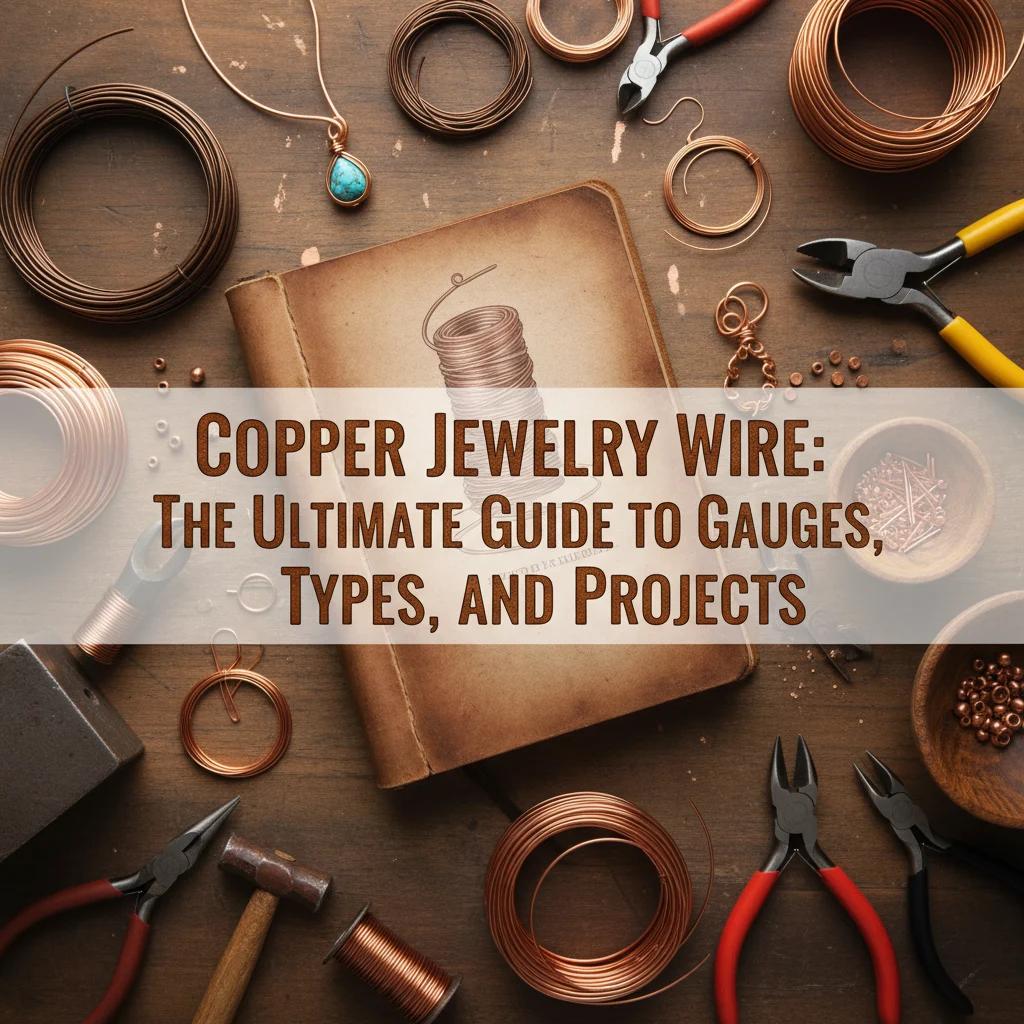[Get the best value wire copper jewelry on Amazon today!]
# Copper Jewelry Wire: The Ultimate Guide to Gauges, Types, and Projects
Creating stunning copper jewelry is an art form, and like any art, it requires the right tools and materials. When it comes to jewelry making, copper wire is a fantastic choice – it’s beautiful, versatile, and relatively inexpensive. But with so many options available, how do you choose the right **wire copper jewelry** for your project?
This ultimate guide will walk you through everything you need to know about copper jewelry wire, from understanding gauges and types to finding inspiration for your next creative endeavor. Whether you’re a seasoned jewelry maker or just starting out, this guide will equip you with the knowledge to select the perfect copper wire for your needs. Let’s dive in!
[Browse top-rated wire copper jewelry on Amazon]
## Understanding Copper Wire Gauges
One of the first things you’ll encounter when shopping for copper jewelry wire is the gauge. Gauge refers to the thickness of the wire, and it’s essential to understand this measurement to choose the right wire for your project. The *higher* the gauge number, the *thinner* the wire.
Here’s a breakdown of common copper wire gauges used in jewelry making:
* **12-14 Gauge (Thickest):** These thicker gauges are ideal for creating sturdy components like bangles, cuffs, and heavy-duty wire wrapping. They provide a strong foundation and can withstand more wear and tear.
* **16-18 Gauge (Medium-Thick):** A versatile choice for creating jump rings, clasps, and wire-wrapped pendants. They offer a good balance of strength and flexibility.
* **20-22 Gauge (Medium):** Perfect for creating ear wires, delicate wire wrapping, and intricate designs. They are easy to manipulate and create detailed patterns.
* **24-28 Gauge (Thin):** These thinner gauges are best for weaving, coiling, and adding fine details to your jewelry pieces. They are very flexible and can be used to create delicate textures.
* **30 Gauge and Higher (Very Thin):** Used for very fine detail work, bead stringing (with very small beads), and adding delicate accents. These are quite fragile and best for experienced jewelry makers.
When choosing a gauge, consider the following:
* **The Size and Weight of Your Project:** Larger, heavier pieces will require thicker gauges for stability.
* **The Complexity of Your Design:** Intricate designs may benefit from thinner gauges that are easier to manipulate.
* **The Desired Aesthetic:** Thicker wires create a bolder, more substantial look, while thinner wires offer a more delicate appearance.
* **Your Skill Level:** Beginners might find it easier to work with medium gauges (16-22), while experienced jewelers can handle the challenges of thinner or thicker wires.
[Browse top-rated wire copper jewelry on Amazon]
## Exploring Different Types of Copper Jewelry Wire
Beyond gauge, copper jewelry wire comes in various types, each with its own unique properties and benefits. Here’s an overview of the most common types:
* **Bare Copper Wire:** This is the most basic type of copper wire, and it’s uncoated, allowing the natural beauty of the copper to shine through. It’s relatively inexpensive and easy to work with, but it will tarnish over time. This tarnish can be embraced for a rustic look, or it can be removed with polishing. Bare copper wire is great for practicing techniques and experimenting with designs before committing to more expensive materials.
* **Enamelled Copper Wire:** This wire has a thin coating of enamel, which protects the copper from tarnishing and adds color. Enamelled copper wire is available in a wide range of colors and finishes, making it a great choice for adding visual interest to your jewelry. It can be a little more challenging to work with than bare copper wire, as the enamel coating can chip if bent too sharply.
* **Tinned Copper Wire:** Tinned copper wire is coated with a thin layer of tin, which makes it solderable and resistant to corrosion. It’s a popular choice for electronics projects, but it can also be used in jewelry making, especially for creating connections that need to be soldered. Tinned copper wire has a silver color, which can be a nice contrast to the warm tones of bare copper.
* **Artistic Wire:** This is a brand name for permanently colored copper wire. It’s coated with a durable enamel that is resistant to scratching and chipping. Artistic Wire is available in a wide range of colors and gauges, making it a versatile choice for all sorts of jewelry projects.
* **Silver-Plated Copper Wire:** This wire has a thin layer of silver plated over the copper core. This gives the appearance of sterling silver at a lower cost. It’s important to note that the silver plating can wear off over time, especially with frequent wear or exposure to harsh chemicals.
* **Gold-Plated Copper Wire:** Similar to silver-plated wire, gold-plated copper wire features a thin layer of gold over the copper core. It offers the look of gold at a fraction of the price. However, the gold plating can also wear off over time, so it’s best suited for occasional wear or pieces that are not exposed to harsh conditions.
[Browse top-rated wire copper jewelry on Amazon]
## Essential Tools for Working with Copper Wire
To successfully work with **wire copper jewelry**, you’ll need a few essential tools. Investing in quality tools will make the process easier and more enjoyable.
* **Wire Cutters:** Used for cutting copper wire to the desired length. Choose wire cutters specifically designed for jewelry making, as they will provide a clean, flush cut.
* **Round Nose Pliers:** Used for creating loops and curves in the wire. They are essential for making ear wires, jump rings, and other components.
* **Chain Nose Pliers:** Used for gripping and manipulating the wire. They have a flat, smooth surface that won’t damage the wire.
* **Flat Nose Pliers:** Used for flattening and straightening the wire. They are also useful for gripping and manipulating small components.
* **Nylon Jaw Pliers:** These pliers have nylon jaws, which prevent scratching or marring the surface of the wire. They are ideal for working with delicate or coated wires.
* **Wire Straightener:** A tool used to remove kinks and bends from the wire. This is especially helpful when working with wire that has been stored on a spool.
* **Files:** Used for smoothing and finishing the ends of the wire.
* **Ruler or Measuring Tape:** Used for accurately measuring the wire.
* **Jeweler’s Hammer and Steel Block:** Used for hardening and shaping the wire.
[Browse top-rated wire copper jewelry on Amazon]
## Inspiring Copper Jewelry Projects
Now that you understand the basics of copper jewelry wire, let’s explore some inspiring project ideas.
### 1. Wire-Wrapped Pendants
Wire wrapping is a technique that involves using wire to secure and embellish gemstones, beads, or other objects. Copper wire is an excellent choice for wire-wrapped pendants, as it’s easy to manipulate and adds a warm, rustic touch.
**Materials:**
* Copper wire (18-20 gauge for the base, 24-26 gauge for wrapping)
* Gemstone or bead
* Wire cutters
* Round nose pliers
* Chain nose pliers
**Instructions:**
1. Cut a length of 18-20 gauge copper wire and bend it into a loop to form the base of the pendant.
2. Wrap the wire around the gemstone or bead, securing it in place.
3. Use 24-26 gauge copper wire to add decorative wraps around the base wire.
4. Create a bail at the top of the pendant for hanging it on a chain.
### 2. Copper Wire Earrings
Copper wire can be used to create a wide variety of earrings, from simple studs to elaborate dangles.
**Materials:**
* Copper wire (20-22 gauge for ear wires, 24-26 gauge for embellishments)
* Beads or crystals
* Wire cutters
* Round nose pliers
* Chain nose pliers
* Earring hooks
**Instructions:**
1. Create ear wires using 20-22 gauge copper wire and round nose pliers.
2. Use 24-26 gauge copper wire to create dangles or embellishments.
3. Attach beads or crystals to the dangles.
4. Attach the dangles to the ear wires.
### 3. Copper Wire Rings
Copper wire can be used to create unique and stylish rings.
**Materials:**
* Copper wire (16-18 gauge for the base, 24-26 gauge for embellishments)
* Wire cutters
* Round nose pliers
* Chain nose pliers
* Ring mandrel
**Instructions:**
1. Cut a length of 16-18 gauge copper wire and wrap it around a ring mandrel to form the base of the ring.
2. Use 24-26 gauge copper wire to add decorative wraps around the base wire.
3. Hammer the ring to harden it and shape it to the desired size.
### 4. Copper Wire Bracelets
Copper wire bracelets can be created using a variety of techniques, including wire wrapping, coiling, and weaving.
**Materials:**
* Copper wire (14-16 gauge for the base, 24-26 gauge for embellishments)
* Beads or crystals
* Wire cutters
* Round nose pliers
* Chain nose pliers
* Bracelet mandrel
**Instructions:**
[Check the latest prices and deals for wire copper jewelry on Amazon today!]



![Bracelet Charms with Clasp: The Ultimate Buying Guide [2026]](https://www.bestbeadboardreviews.com/wp-content/uploads/2025/11/bracelet-charms-with-clasp-150x150.webp)






